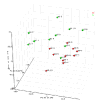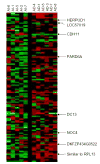Molecular alterations in primary prostate cancer after androgen ablation therapy
- PMID: 16203770
- PMCID: PMC1432092
- DOI: 10.1158/1078-0432.CCR-05-0585
Molecular alterations in primary prostate cancer after androgen ablation therapy
Abstract
Purpose: After an initial response to androgen ablation, most prostate tumors recur, ultimately progressing to highly aggressive androgen-independent cancer. The molecular mechanisms underlying progression are not well known in part due to the rarity of androgen-independent samples from primary and metastatic sites.
Experimental design: We compared the gene expression profiles of 10 androgen-independent primary prostate tumor biopsies with 10 primary, untreated androgen-dependent tumors. Samples were laser capture microdissected, the RNA was amplified, and gene expression was assessed using Affymetrix Human Genome U133A GeneChip. Differential expression was examined with principal component analysis, hierarchical clustering, and Student's t testing. Analysis of gene ontology was done with Expression Analysis Systematic Explorer and gene expression data were integrated with genomic alterations with Differential Gene Locus Mapping.
Results: Unsupervised principal component analysis showed that the androgen-dependent and androgen-independent tumors segregated from one another. After filtering the data, 239 differentially expressed genes were identified. Two main gene ontologies were found discordant between androgen-independent and androgen-dependent tumors: macromolecule biosynthesis was down-regulated and cell adhesion was up-regulated in androgen-independent tumors. Other differentially expressed genes were related to interleukin-6 signaling as well as angiogenesis, cell adhesion, apoptosis, oxidative stress, and hormone response. The Differential Gene Locus Mapping analysis identified nine regions of potential chromosomal deletion in the androgen-independent tumors, including 1p36, 3p21, 6p21, 8p21, 11p15, 11q12, 12q23, 16q12, and 16q21.
Conclusions: Taken together, these data identify several unique characteristics of androgen-independent prostate cancer that may hold potential for the development of targeted therapeutic intervention.
Figures


References
-
- Abate-Shen C, Shen M. Molecular genetics of prostate cancer. Genes Dev. 2000;14:2410–34. - PubMed
-
- Feldman BJ, Feldman D. The development of androgen-independent prostate cancer. Nat Rev Cancer. 2001;1:34–45. - PubMed
-
- Chen CD, Welsbie DS, Tran C, et al. Molecular determinants of resistance to antiandrogen therapy. Nature Med. 2004;10:33–9. - PubMed
-
- Dhanasekaran SM, Barrette TR, Ghosh D, et al. Delineation of prognostic biomarkers in prostate cancer. Nature. 2001;412:822–6. - PubMed
-
- LaTulippe E, Satagopan J, Smith A, et al. Comprehensive gene expression analysis of prostate cancer reveals distinct transcriptional programs associated with metastatic disease. Cancer Res. 2002;62:4499–506. - PubMed
Publication types
MeSH terms
Substances
Grants and funding
LinkOut - more resources
Full Text Sources
Other Literature Sources
Medical
Molecular Biology Databases

